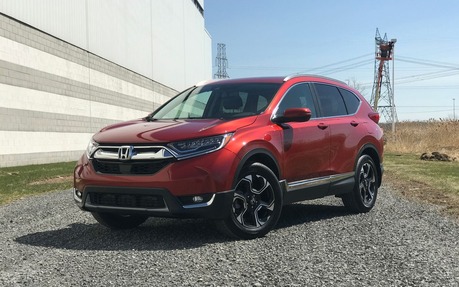2018 Honda CR-V: on Top of its Game
The Honda CR-V is one of the best-selling vehicles in Canada. The only ones that people buy more of are the three full-size pickup trucks from the American manufacturers, the Honda Civic and the Toyota RAV4 (barely). Only 451 more RAV4s were sold in 2017 compared to the 50,443 CR-Vs that Honda sold that same year. Toyota had enjoyed a gap compared to its immediate rival in previous years, but Honda has now virtually erased it thanks in part to the all-new fifth generation 2017 CR-V.
The current-generation CR-V looks much more modern, rugged and tougher than the previous generation. Aggressive stylized headlights surrounded by wing-shaped LED daytime running lights on all trim levels, wider fenders, a long hood, a short rear overhang and new dual exhaust tips give the CR-V a more athletic presence.
Sitting in the CR-V, I was immediately comfortable with all my surroundings and was pleasantly surprised to note the presence of a physical shift lever and volume knob. The shifter is likely still a dying breed, but Honda had experimented with tiny touchscreen buttons for volume control and it was not a good setup at all. One complaint I do have is with the volume control on the steering wheel. It’s a touch-sensitive interface as well as a button, meaning you can push it or slide your finger over it to change the volume, but I often modified it by accident.
The leather seats found on this Touring model were excellent in terms of support and comfort. The cockpit gives an extremely high-end feel thanks in part to the combination of brushed aluminum, wood and leather which adorn most surfaces. The CR-V’s new TFT driver information interface (also known as the gauge cluster) does away with the traditional design and opts for a much more modern numerical speed readout with the tachometer info above it.

The standard seven-inch touchscreen display audio interface is compatible with Android Auto and Apple CarPlay. Nestled right on the dash rather than protruding up like in many other cars, the screen positioning makes for a smoother look. That android-based system is better than previous ones, but is still not quite at the level of ease-of-use as, say, Chrysler’s Uconnect or Ford’s SYNC 3.
Under the hood we find a 1.5-litre turbocharged four-cylinder engine with 190 horsepower and 179 lb.-ft. of torque across all trim levels. This engine is paired with a continuously variable automatic transmission and is offered with a front-wheel drivetrain or with a reengineered Real Time AWD system. The setup has more than enough power to deliver a peppy ride with smooth acceleration across the whole power band. Furthermore, it allows the CR-V to achieve the best fuel economy in the (non-hybrid) compact crossover class. During my week, I averaged 9.7 L/100 km with mainly city driving. Although higher than the advertised numbers, I was still pleasantly surprised given my driving habits.
The CR-V is also very spacious both for occupants and for cargo. There are 1110 litres of space behind the second row and you can increase the dimensions by removing the floor of the cargo area. Folding the seats down will yield 2146 litres of cargo space.
During my week with the CR-V, I tried to find something I didn’t’ like about it, but there really wasn’t much. I packed three kids into it with ease (thanks to near 90-degree door openings), transported groceries with ease, executed highway passes up to 120 km/h without issue and did so without burning too much fuel and looking great in a classy, modern-looking vehicle.
You can get a base CR-V LX with front-wheel drive for $27,290 before transport, but it’s unlikely Honda will sell many of these. Canadians want crossovers that can handle our harsh winters and the AWD versions fill the bill. The list of standard features is impressive. For example, even on that base LX you get heated front seats, Bluetooth connectivity, the seven-inch touchscreen infotainment system, proximity key entry system with pushbutton start, two front USB charging ports, Apple CarPlay, Android Auto as well as a remote engine starter. That’s a heck of a lot for the least expensive trim level.
The LX with AWD will add a slew of safety features for $30,090, the EX ($33,590) upgrades the interior finishes, sound system, wheels and a few other things, the EX-L ($35,890) adds leather plus a power tailgate and the Touring adds ambient lighting, a premium audio system, LED headlights, dual exhaust tips, roof rails and a blind spot information system, ringing in at $38,690 plus $1,910 transport.
| Test drive report | |
| Test model | 2018 Honda CR-V |
|---|---|
| Trim level | Touring |
| Price range | $27,090 – $38,490 |
| Price as tested | CA$38,490 |
| Warranty (basic) | 3 years/60,000 km |
| Warranty (powertrain) | 5 years/100,000 km |
| Fuel economy (city/highway/observed) | 8.7 / 7.2 / 9.7 L/100km |
| Options | N/A |
| Competitive models | Chevrolet Equinox, Dodge Journey, Ford Escape, GMC Terrain, Hyundai Tucson, Jeep Cherokee, Kia Sportage, Mazda CX-5, Mitsubishi Outlander, Nissan Rogue, Subaru Forester, Toyota RAV4, Volkswagen Tiguan |
| Strong points |
|
| Weak points |
|
| Editor's rating | |
| Fuel economy | Excellent for a crossover. |
| Comfort | Very comfortable all around. |
| Performance | Not the quickest, but good enough. |
| Infotainment | Good that the volume knob is back, but menus could use a redesign. |
| Driving | Very satisfying to drive. |
| Overall | A fine package that does well in this cutthroat segment. |
